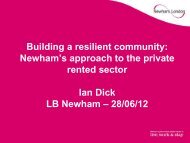View publication - Chartered Institute of Housing
View publication - Chartered Institute of Housing
View publication - Chartered Institute of Housing
Create successful ePaper yourself
Turn your PDF publications into a flip-book with our unique Google optimized e-Paper software.
PART ONE: LEARNING TODAY<br />
c) Fragmentation and specialisation within the industry will create a diversity <strong>of</strong> business<br />
models (differing sources <strong>of</strong> revenue, a diversity <strong>of</strong> cost bases, and a re-evaluation <strong>of</strong><br />
the investment/capital acquisition criteria).<br />
d) A fundamental shift in how social housing providers use technology to deliver a more<br />
personalised service. 42<br />
In the same vein, Sch<strong>of</strong>ield (2008) highlights the challenges within the public sector:<br />
I. Increasing pace <strong>of</strong> change.<br />
II. Technological developments.<br />
III. Changing perceptions.<br />
IV. Increasing expectations.<br />
V. Citizen empowerment.<br />
VI. Changing workforce.<br />
VII. Changing environment.<br />
Current and aspiring leaders in social housing can look at the highlights illustrated in the<br />
above paragraph and mutter, ‘we have seen it all before’ – and they would be largely<br />
correct. However, that is also the problem – the solutions that they may have<br />
(inadvertently) put forward have not fundamentally changed their organisations or<br />
sustainably resolved the underlying causes <strong>of</strong> the situation.<br />
What was the ‘Right Stuff’?<br />
The practice <strong>of</strong> leadership in social housing is understandably diverse and no single<br />
model or approach can satisfactorily demonstrate the richness that is observed.<br />
However, on a generic level, leaders in social housing can sometimes be viewed as<br />
calling on their ability to assess the situation, stabilise the condition, and buy time to<br />
find a robust solution. In this context, successful leadership is viewed as comprising <strong>of</strong>:<br />
analytical problem solving, clear decision making and the articulation <strong>of</strong> direction.<br />
Sounds about right...with one problem...if the solution was so good, why does the<br />
problem continue to re-appear?<br />
Ronald Heifetz and colleagues at the JFK School <strong>of</strong> Government at Harvard University<br />
have been examining the application <strong>of</strong> ‘technical leadership’. This approach can be<br />
effective in certain circumstances:<br />
a) When there is a clear problem and solution.<br />
66

















